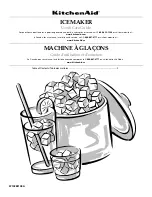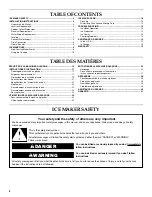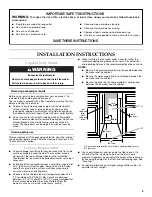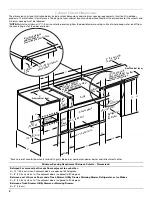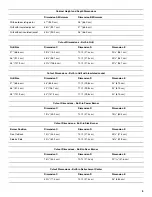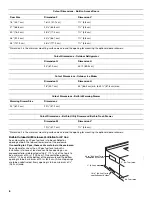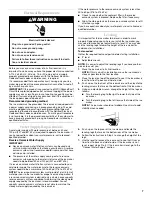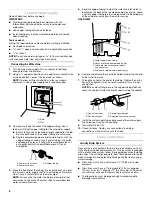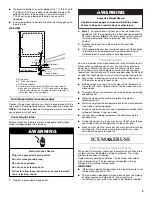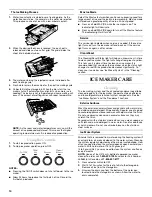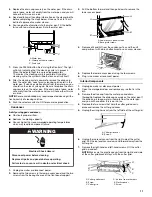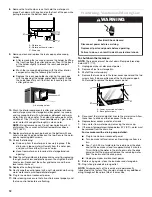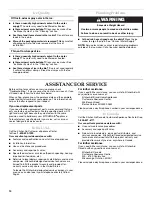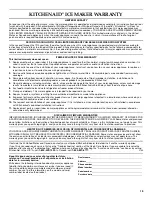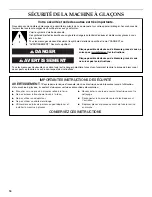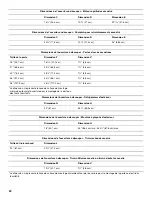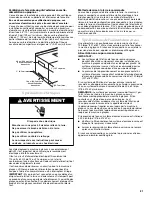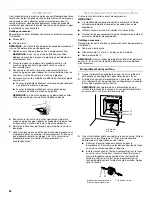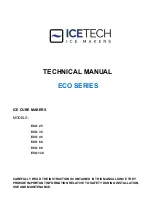
8
Connect Water Supply
Read all directions before you begin.
IMPORTANT:
■
Plumbing shall be installed in accordance with the
International Plumbing Code and any local codes and
ordinances.
■
Use copper tubing and check for leaks.
■
Install tubing only in areas where temperatures will remain
above freezing.
Tools needed:
Gather the required tools and parts before starting installation.
■
Flat-blade screwdriver
■
⁷⁄₁₆
" and
¹⁄₂
" open-end wrenches or two adjustable wrenches
■
¹⁄₄
" nut driver
NOTE: Do not use a piercing-type or
³⁄₁₆
" (4.76 mm) saddle valve
which reduces water flow and clogs more easily.
Connecting the Water Line
1. Turn off main water supply. Turn on nearest faucet long
enough to clear line of water.
2. Using a
¹⁄₂
" copper supply line with a quarter-turn shutoff valve
or the equivalent, connect the ice maker as shown.
NOTE: To allow sufficient water flow to the ice maker a
minimum
¹⁄₂
" size copper supply line is recommended.
3. Now you are ready to connect the copper tubing. Use
¹⁄₄
"
(6.35 mm) OD soft copper tubing for the cold water supply.
■
Ensure that you have the proper length needed for the job.
Be sure both ends of the copper tubing are cut square.
■
Slip the compression sleeve and compression nut on the
copper tubing as shown. Insert end of tubing into outlet
end squarely as far as it will go. Screw compression nut
onto outlet end with an adjustable wrench. Do not
overtighten.
4. Place the free end of the tubing into a container or sink, and
turn on main water supply and flush out tubing until water is
clear. Turn off shutoff valve on the water pipe.
NOTE: Always drain the water line before making the final
connection to the inlet of the water valve to avoid possible
water valve malfunction.
5. Bend the copper tubing to meet the water line inlet which is
located on the back of the ice maker cabinet as shown. Leave
a coil of copper tubing to allow the ice maker to be pulled out
of the cabinet or away from the wall for service.
REAR VIEW
6. Remove and discard the short, black plastic tube from the end
of the water line inlet.
7. Thread the nut onto the end of the tubing. Tighten the nut by
hand. Then tighten it with a wrench two more turns. Do not
overtighten.
NOTE: To avoid rattling, be sure the copper tubing does not
touch the cabinet’s side wall or other parts inside the cabinet.
8. Install the water supply tube clamp around the water supply
line to reduce strain on the coupling.
9. Turn shutoff valve ON.
10. Check for leaks. Tighten any connections (including
connections at the valve) or nuts that leak.
Drain Connection
Gravity Drain System
Connect the ice maker drain to your drain in accordance with all
state and local codes and ordinances. If the ice maker is provided
with a gravity drain system, follow these guidelines when installing
drain lines. This will help keep water from flowing back into the ice
maker storage bin and potentially flowing onto the floor causing
water damage.
■
Drain lines must have a minimum of
⁵⁄₈
" (15.88 mm) inside
diameter.
■
Drain lines must have a 1" drop per 48" (2.54 cm drop per
122 cm) of run or
¹⁄₄
" drop per 12" (6.35 mm per 30.48 cm) of
run and must not have low points where water can settle.
■
The floor drains must be large enough to accommodate
drainage from all drains.
A. Bulb
B. Nut
A. Compression sleeve
B. Compression nut
C. Copper tubing
A
B
B
C
A
A. Water supply tube clamp
B. Vent hose (drain pump models only)
C. Inlet water tube clamp and supply
line connector
D. Drain hose (drain pump models only)
A. Line to ice maker
B. Nut (purchased)
C. Ferrule (purchased)
D. Supplied line from ice maker
A
C
D
B
D
A
B
C

